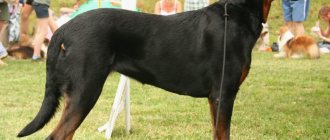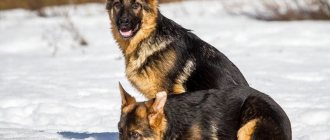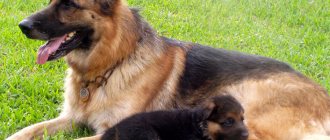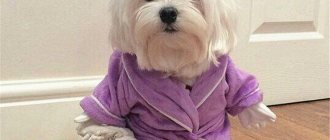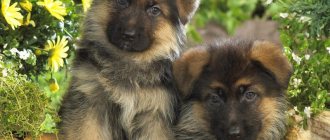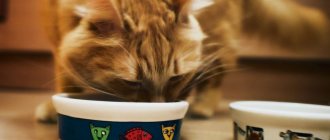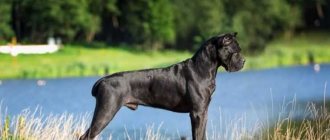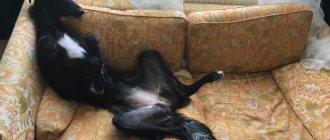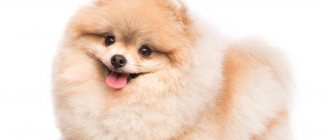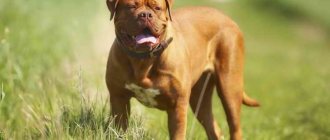Breed characteristics
| Short description | |
| Origin: | France |
| Conditions of detention: | In the apartment |
| Purpose: | Hunting, companion, guard |
| Color: | Red, black, gray and variations of these colors |
| Wool length: | In some places it reaches 50 cm |
| Adult dog size: | Height of females – 56-65 cm, males 58-65 cm, weight of males 30-45 kg, females – 25-30 kg |
| Average life expectancy: | 10-12 years |
| Walk: | 2 times a day for 1.5-2 hours |
| Physical activity needs: | High physical activity needs (daily exercise of more than 3 hours per day) |
| Fédération Cynologique Internationale (FIC) classification: | Group 1: Shepherds and cattle herders; Section 1: Shepherds |
| Puppy price: | from 15 to 45 thousand rubles. |
History of the origin of the species
The appearance of this breed dates back to the 12th century. It was from this time that the first written mention of a dog resembling a Briard in appearance dates back to this time. There is also a version that representatives of this breed come from the famous Persian dog.
Close relatives of Briards also include the well-known Beauceron herding dog breed. However, they have little in common, except perhaps their purpose and massiveness. Previously, this breed was often used for looking after animals (especially sheep) and for driving livestock. Therefore, researchers came to the conclusion that Briards were once inhabitants of the wild. This is also indicated by some of the dogs’ habits and the absence in the archives of any data on the artificial breeding of the breed.
Even in the last century, scientists noticed that French Shepherd puppies are born dark and with soft hair, and then gradually lighten and by the age of 3 acquire a stable coat color. This is explained by the fact that Briards have the wound graying gene . This feature does not apply to black puppies; they remain unchanged from the moment they are born.
At the end of the 19th century, when the breed had a standard, these dogs began to rapidly gain fame and take an active part in international exhibitions. At the same time, dogs of this breed appeared at the court of the Russian emperor. However, any breeding work with them was not successful.
Thanks to their excellent character traits, and especially obedience, Briards had the honor of serving at the front (to find wounded soldiers and supply ammunition). Representatives of this breed were once kept by Napoleon and Henry Lafayette.
History of the origin of the Briard breed
The ancestors of the Briard, like most other herding breeds, came to Europe with the eastern tribes of nomads. In France, a traditional pastoral country, they have become an integral part of farming. The name Briard Sheepdog, emphasizing territorial affiliation, first appeared in the 19th century. This is exactly what Abat Rosier called large, long-haired dogs that can herd livestock and have other talents in his work “A Course in Agriculture.”
Officially, the history of the breed begins in 1963, when Briards were first introduced to the show. Briards were included in the stud book of French dogs in 1885. In 1897, the French Shepherd Lovers Club developed and approved a standard.
During the world wars, dogs were used by the French army for communication between sentries, as orderlies and as search dogs. In the post-war years, the breed was on the verge of extinction, but, through the efforts of enthusiasts, it was completely restored and even made better. To improve their appearance, breeders infused the Briards with the blood of Barbets and Bosserons.
Briards can be found in films, mostly family comedies, such as “Dennis the Menace” and “The Karate Dog.”
Video review about the Briard dog breed:
Distinctive features
Appearance is the calling card of French Shepherds and Briards are no exception. The first thing worth noting is, of course, the thick and long hair, which often covers the dog’s eyes. In addition, the distinctive features of this breed are:
- The head is large, powerful and slightly elongated. The muzzle is distinguished by abundant hair. The nose is characterized by a black square lobe and powerful nostrils.
- The eyes are horizontally set, well opened, black and dark brown in color. Gray dogs may have gray eyes. A questioning look.
- The ears are thick, set high, covered with long hair.
- The teeth are small, snow-white, strong. The bite is correct.
- The neck is set high and muscular.
- The paws are strong and have a rounded shape (intermediate between a cat's paw and a rabbit's paw).
- The tail is long, with abundant hair, and forms a hook at the end.
- a long coat that feels like goat hair to the touch. The younger the dog, the softer the six. Briard puppies are born dark. A stable coat color in Briards appears only at 3 years of age.
Photo of an adult dog
Photos of puppies
Features of character and behavior
To begin with, it is worth noting that, despite their impressive size, Briards are quite friendly and kind dogs. However, their character largely depends on their upbringing and owner. If a person treats a pet with understanding and love, then the dog will respond in kind. If the owner shows rudeness and evil towards the dog, then it will definitely harbor a grudge and take revenge.
Advantages
- Representatives of this breed are friendly and intelligent. They easily get along with a person and become attached to him.
- They are very hardworking and quickly learn new things.
- Briards love children, so it is difficult to tear them away from watching them. This is also influenced by the instinct of an excellent shepherd.
- These dogs remain active and energetic until old age.
- They love to be in society and require a lot of attention from others.
- If you get such a pet, you will receive boundless love and devotion from him.
Flaws
- If there are other animals in the house besides the Briard, the dog may experience attacks of jealousy.
- In cases of neglect by the owner or undeserved punishment, the dog may be offended for a while. But in this case, you just need to pet the pet, and everything will pass.
As a puppy, the Briard carefully studies its owner, takes into account his weaknesses in order to begin to manipulate people in the future. Therefore, raising and training a dog of this breed should be done from the first days of its life.
Character of the breed
The “Frenchman” has a very complex and rather contradictory character . On the one hand, he is cheerful, playful, affectionate and flexible, endlessly attached to his only beloved owner. But on the other hand, the dog is independent and independent, sometimes stubborn, jealous and touchy. He demands increased attention and loves to be at the epicenter of events. Long periods of forced loneliness and the absence of owners are extremely difficult to endure. An active and energetic pet retains a lively temperament and puppy spontaneity until old age.
This French Shepherd treats children reverently and tenderly; he will never refuse to frolic and play with them, but he will not tolerate familiarity and rudeness towards himself. He perceives other domestic animals living in the same territory as rivals, but tolerates them, considering them part of his herd. The dog does not forget to herd his charges and collect those who have strayed from the pack.
Representatives of the breed do not stand on ceremony with other dogs, so if someone else’s “tail” comes into the animal’s field of vision, get ready for a conflict, or even a serious fight. Things are almost the same with cats, with the exception of those pets with whom the dog spent his childhood and adolescence.
The breed is not prone to aggression; dogs are usually quite reserved and wary with strangers. The shepherd's protective qualities are innate; she is always vigilant, alert and alert, ready to rush to defense without delay.
Briard Shepherds are very active and restless dogs.
Owners note that Brie dogs have rich and interesting facial expressions with which they express their emotions.
Care and maintenance
When caring for a Briard, special attention should be paid to the ears, eyes and paws, which should be carefully inspected and cleaned.
- Eyes and ears can be wiped with a cotton swab.
- If the dog does not lead a very active lifestyle and the nails do not have time to wear down naturally, then the owner should cut them himself. These simple procedures will serve to prevent the development of viral diseases.
Nutrition
When purchasing this pet, you need to take into account that it eats quite a lot. Like many dogs of other breeds, Briards are allowed to include food of natural origin and high-quality food into their diet. This aspect should be taken seriously as it requires an individual approach. At the same time, you cannot introduce a mixed diet, as this can harm the health of your four-legged friend.
- A balanced diet should be introduced, the main ingredients of which should be meat, vegetables, grains and herbs .
- It is recommended to exclude potatoes, rice, any confectionery, smoked and baked products from the menu.
The diet of a puppy differs from the diet of an adult dog:
- It should contain more dairy and protein products. Therefore, it is recommended to give puppies cottage cheese and kefir, as well as boiled eggs 1-2 times
- Unlike an adult dog, which can be fed twice a day, a puppy requires four meals a day.
The amount and volume of food is affected by the activity and massiveness of the dog’s body. It is also recommended in hot weather to minimize the intake of protein foods and focus on vitamin E.
You can include a small dose of peanut butter in your diet. If you focus on feed additives, then you should choose high-quality food intended for large dogs with long coats. And finally, you need to remember that the active lifestyle of the Brirs makes them drink a lot. Therefore, the dog should have unlimited access to fresh water.
Health
Pets of this breed live more than 10 years and rarely suffer from any diseases. As a rule, the first health problems appear in dogs over 7 years of age .
Vaccinations
Briards are vaccinated against the following diseases:
- parvovirus enteritis;
- viral hepatitis;
- leptospirosis;
- coronavirus;
- trichophytosis.
- rabies;
- parainfluenza;
- plague.
The first vaccination is carried out no earlier than 9 weeks, then the procedure is repeated after one month. In the future, vaccination is carried out once a year.
10 days before vaccination, the animal is treated for worms. After vaccination, the Briard must be isolated from other dogs and animals for 2 weeks. As a rule, there are no problems with a dog after vaccination.
Diseases
- These pets are prone to volvulus . In such cases, surgery cannot be avoided.
- Almost all Briards suffer from night blindness and a condition associated with increased retinal detachment .
- A small number of pets have a problem associated with hip or elbow .
- In addition, among these animals there are individuals suffering from epilepsy .
The main problem of all dogs with long hair remains parasites: fleas, ticks, helminths. Briards have a hereditary allergy to flea bites. Therefore, it is very important to carefully examine the dog after walks and regularly contact a veterinary clinic for treatment against parasites.
Walk
Long, active walks in nature are an essential part of raising a Briard.
Constantly sitting at home will become torture not only for the dog, but also for its owner. Therefore, it is necessary to walk 2 times a day for 1.5-2 hours .
At this time, it is important to train your pet, engage in active games and jogging.
During walks, the dog needs to be occupied with games and given different commands. It should be borne in mind that all exercises should be interesting; the Briard will get bored from tedious and one-time tasks. In addition, your pet should be let off the leash more often so that it can run around to its heart's content.
Grooming
The main pride of French Shepherds is their long hair. To make it shiny and well-groomed, the pet owner needs to make a lot of effort:
- The coat needs to be combed 1-2 times every 8-10 days . In this case, it will not get tangled and will look clean and well-groomed.
- In addition, once every 3 months .
- Apartment pets should be bathed at least once a month, aviary pets can be washed a couple of times a year . However, you cannot do this often.
- Because the animal may develop skin problems. Before bathing, the dog should be combed, paying special attention to the undercoat.
- Hair should also be trimmed regularly .
Features of care
In order for your pet to look neat, it will need regular and proper grooming.
Hygiene
A set of hygiene procedures:
- Periodically (every 5-7 days) examine the ears and eyes, clean the dirt with cotton swabs or sticks with veterinary lotion or herbal decoction (calendula, chamomile, etc.). If the ears are undocked, then the hair inside the shell is cut off.
- They brush their teeth weekly with a special paste for animals that does not require rinsing, and a finger brush attachment.
- The claws are shortened with a guillotine nail clipper if they do not grind down on their own during walks.
- After each meal, the face is washed with water or wiped with wet wipes, removing any remaining food. The beard and mustache must be combed. The bangs are thinned out a little (filed) or pinned into a ponytail. For non-show animals it can be shortened.
- Trim any clumps of fur between the toes (as needed).
- The wool is carefully combed daily, first with a wide comb, removing debris and working out tangles, then with a fine-toothed comb or brush. During the procedure, conditioners are used to make combing easier.
- Water treatments are carried out 1–2 times a month, using professional cosmetics (shampoos, conditioners, balms, etc.) for long-haired animals.
The dog's long, dry hair hardly sheds, but it becomes intensely matted. So if you don’t want your pet’s body to turn into a solid, untidy “felt boot,” don’t neglect brushing it daily.
For a long-haired dog to go outside, it is better to buy protective overalls, so that later burrs and other surprises of nature are not pulled out of the fur. Our dog, for example, also loved to roll in the dust or swim in a puddle of dirty water.
Walk
Shepherd dogs require regular (2-3 times a day), long (at least an hour) walks with good physical activity. Lack of physical activity has an extremely negative impact on the character of dogs.
You need to walk a Briard a lot, and it’s better without a leash.
This breed is most suitable for people leading an active lifestyle, who can take their pet on trips out of town, cycling, hiking, morning jogging in the park, etc.
Nutrition
Very active dogs especially need a complete and balanced diet . For the “Frenchies,” special super-premium or holistic food is selected, intended for active pets (Acana Heritage Adult Large Breed, Royal Canin HE Club, etc.). Homemade, freshly prepared food will also work. Adult dogs are fed twice a day, puppies - from 3 to 6 times depending on age.
The natural diet includes:
- lean meats (horse meat, veal, turkey, etc.);
- meat trimmings and offal;
- porridge (oatmeal, buckwheat, etc.);
- seasonal fruits and vegetables, herbs;
- sea fish without bones;
- low-fat sour milk (cottage cheese, kefir, etc.);
- eggs;
- unrefined vegetable oil;
- mineral complexes and vitamin supplements.
Shepherds should not be given pasta and baked goods, canned food, potatoes, legumes, as well as fatty and sweet foods.
Mating
- The first estrus in these animals occurs at 8-10 months of life. But this early the female is not yet ready for mating.
- A dog of this breed will be ready to bear offspring only in the second year of life, or rather, during the third estrus.
- The female is ready for mating on the 10-12th day of estrus.
- Males are ready by 1.5 years . However, this process occurs individually in each animal. Therefore, the timing may vary. An experienced female is selected for an inexperienced male and vice versa.
As a rule, a female is brought to the male and given time to become friends. At the same time, it is necessary to ensure a calm environment, otherwise the pets will get scared and twitch. To breed healthy puppies, a purebred partner is selected.
Diseases
A healthy Briard lives up to 10 years, or even more. But there are a number of diseases that are characteristic of herding dogs and are most often diagnosed in this breed:
- Hip dysplasia is found in 20% of Briards. To protect your pet from this disease, you need to regularly take x-rays.
- Gastric volvulus. If your dog has the following symptoms: vomiting, belching, shortness of breath, then this is a good reason to contact a veterinarian. Only surgical intervention can save the Briard from death.
- Epilepsy.
- Eye diseases: night blindness and progressive retinal atrophy.
- Allergy to flea bites.
Key points in training
Stubbornness and the habit of deciding everything on your own often become an obstacle to training Briards . But those who decide to get a Briard will have to be patient and persevering, because training these dogs is not as easy as it might seem at first glance.
First you need to show the dog who's boss. The main thing here is not to miss the opportunity to become a leader for your pet. Only in this case the training process will seem easy and will bring pleasure not only to the owner, but also to the pet. In this case, harsh methods of influence cannot be used. This can lead to resentment on the part of the pet.
Read about how to properly train a dog in the article: “Training a puppy: effective methods from dog handlers, learning commands at home.”
Thanks to their curiosity and ability to learn quickly, these dogs can be taught any canine sport. These dogs are especially good in such areas as pulk and ski joring.
How to choose a puppy
- It is better to buy a Briard puppy at the age of 3 months. By this time they will be fully grown and will be vaccinated. In addition, when buying a puppy, you should consider the condition of the coat. In healthy dogs, it is shiny and soft to the touch. It is worth knowing that over the years, a pet's fur becomes coarser.
- If you are offered a puppy with dull hair, which also falls out, this indicates that the pet lacks vitamins and its entire body is weakened. For the breeder, this will mean only one thing - long and expensive recovery of the pet. Also a sign of poor health of the puppy are uncertain, limping movements.
- If the future owner is poorly versed in dog breeds and is not sure that he can buy a healthy pet with a good pedigree, then it is better to contact a specialist who is better versed in these issues.
In conclusion, it is worth saying that when starting a Briard, you need to understand that it requires certain care and attitude on the part of the owners. Not everyone is ready to make such sacrifices. However, if the issue of buying a puppy is resolved, then after some effort, the dog will give the owner and the whole family a lot of positive impressions and love.
Choosing a puppy
It is better to purchase a French Briard puppy closer to three months , when the puppies are fully strengthened and have received all the necessary vaccinations. Some breeders continue to crop puppies' ears, although according to the requirements of the Animal Welfare Committee in many countries, this procedure has already been abolished and drooping ears are not considered a disqualifying defect.
The Briard has a distinctive feature that they inherited from the Beauceron: on their hind legs they have two dewclaws with bones and claws instead of the usual one (i.e., six toes).
Another interesting point regarding their color: all Briard puppies are born dark , then begin to gradually lighten, and only by the age of three they acquire a stable coat color. In isolated cases, this process may take a little longer. This does not apply to the color black, since it remains unchanged from birth. In any case, the coat of a healthy puppy is shiny and pleasant to the touch. A little later it will begin to change and become tougher.
If the fur is dull and remains on the hands when stroked, then the puppy does not have enough vitamins, which means that his entire body is weakened. You will have to spend a lot of money to restore it. Other signs of possible problems are apathy and uncertain movements with a limp.
If you are not sure that you are well versed in the breed standard, and also that you will be able to select a puppy yourself and check that there are no marks in the documents, then it would be best to take with you a specialist in these matters.
Dog names
If you adopted a puppy from a kennel, you will not have to think long about the name, since it is already indicated in his documents. In other cases, you can use some of the suggested options:
- nicknames for males - Boston, Darius, Gross, Artush, Bright, Demian, Hill, Darf, Bonnie;
- nicknames for bitches - Martha, Ashanti, Bonza, Callie, Vaida, Ilda, Amanda, Jazzy.
Briar price
The fashion for Briards has so far bypassed our country, which is for the best: the breed has practically not suffered from commercial breeding, which means that the chances of purchasing a defective puppy are relatively small. To get your own stylish shaggy dog, a potential buyer will have to travel extensively around the country, since nurseries specializing in briards are not available in every region. As for the prices for puppies, there is a decent range in them, so you can get the dog of your dreams for either 20,000 rubles or 40,000 rubles.
